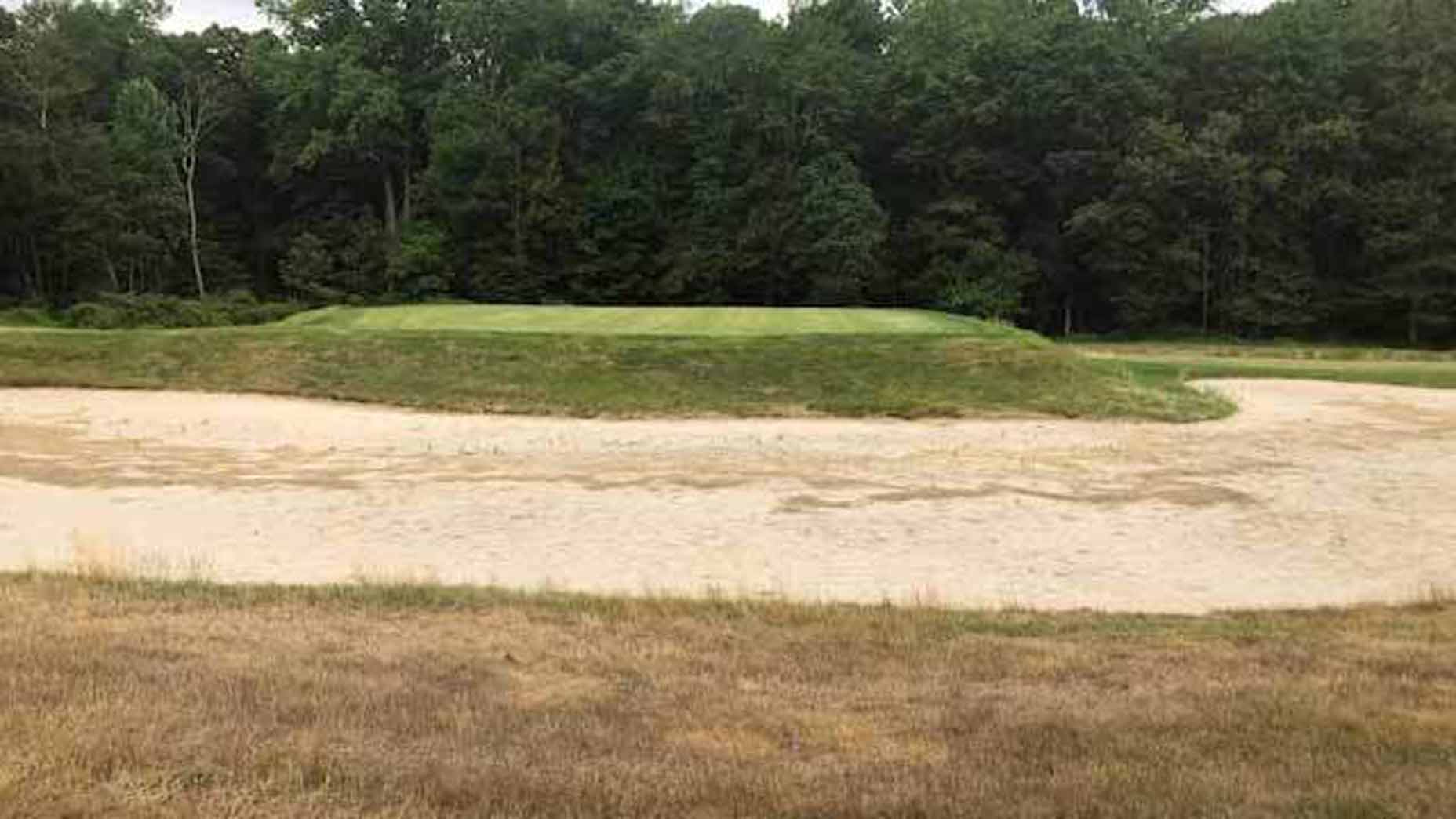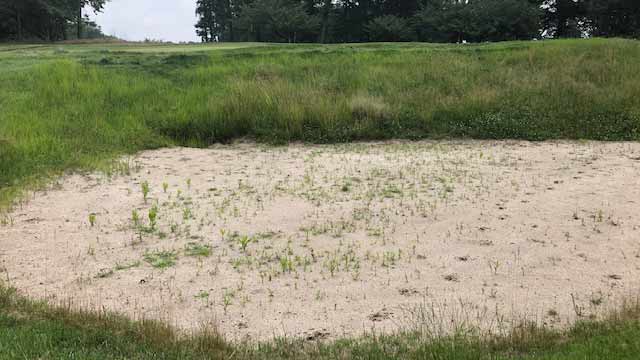
A recent photo of the plateaued 5th green at Yale Golf Course.
It’s an acknowledged masterpiece of golf-course design, the top-rated college layout in the country and a fixture on respected global rankings, listed at 83rd on GOLF Magazine’s latest roster of the Top 100 Courses in the World.
No one would dispute that Yale Golf Course, a Golden Age collaboration by the celebrated architects Seth Raynor and Charles Blair Macdonald — with nods to St. Andrews and North Berwick — is a gem.
But many now feel that it’s a badly tarnished one.
After closing at the end of the 2019 season, the vaunted New Haven, Conn., layout, which sits about four miles west of the Yale campus, has yet to reopen. In early March, its longtime superintendent moved on to another job. Less than two weeks later, the pandemic hit, and the university itself shut down, shifting all of its classes online. With the campus closed and other university facilities darkened, the school was compelled to cut back on course maintenance, reducing its grounds crew to two workers per day for a total of four hours. That skeleton staff kept to the scaled-back schedule for the next three months. Though the staff has now been beefed up to pre-pandemic numbers, there’s no hiding the ill effects.
Recent photos, snapped by members of the semi-private course and shared with GOLF.com, along with other images circulating on social media, show large swaths of burnt out and barren turf. Spotty, unkempt tees give way to forlorn greens and fairways, and bunkers sprouting pygmy forests of weeds.

The famous Biarritz green on Yale’s 9th hole.

A bunker on the 7th hole.
This is not the first time conditions at Yale have been called out. But the impact of the pandemic appears to have pushed matters to a breaking point. Those who have been around the course for decades say that the design has never looked so undernourished.
According to the university, the course will remain closed through Aug. 31, forcing prestigious tournaments to have been either scrapped or relocated.
“This place used to be my Walden,” said Bill Lee, a longtime Yale member, 11-time club champion and member of the Connecticut Golf Hall of Fame. “It didn’t have to be this way.”
Added Gerry Mullally, another longtime member: “The university is more than happy to accept the accolades for its course along with the lofty rankings. But they also have a duty to be good custodians, and they have not embraced that role.”
In an email to GOLF.com, Yale athletic department spokesman Mike Gambardella dismissed the notion that the school was uncommitted to caring for the course. To the contrary, he said, the athletic department has been working on a plan to “bring the course back to its glory.” That plan had been working, Gambardella said, with the course “better maintained last year than previous years.”
Covid-19, he said, threw a wrench in the works.
“Due to university limitations, our ground crew was short staffed for a couple of months but as of last week we are back to fully staffed,” Gambardella said, adding that all decisions have been made with “the safety and well-being of our employees at the forefront.”
He said that the university was looking to bring in “landscape experts” to help with the bunkers and the rough, and that the school was also in the process of hiring a general manager for the course, who in turn would lead a search for a new superintendent.
Gambardella did not give a timeframe for those hires.

The course sits about four miles west of the Yale University campus.
google earth
Yale’s conundrum comes as golf is surging all around it. Throughout Connecticut, tee sheets are jammed, according to Bob Carney of the Connecticut State Golf Association, who attributed the increase to a combination of pent-up demand and good weather.
Carney confirmed that the 80th playing of the Connecticut Four-Ball Championship, slated for July 30 at Yale, has been relocated to Wallingford Country Club, marking the first time in its history that the event will not be held at Yale. According to the university, all fall tournaments at Yale, including the annual member-guest invitational, have been cancelled as well.
Images of Yale in its current state have rekindled conversations that have simmered for years in golf architecture circles, often casting the course as a neglected treasure.
“Is Yale the Greatest Tragedy in Golf?” was the subject line on a lengthy thread that posted on the architecture-focused forum, Golf Club Atlas, as far back as 2003. The question was an echo of an article published around the same time by a prominent architecture critic in a national magazine.
That the course still ranks on prestigious lists despite its checkered maintenance history is further evidence of its inherent greatness, according to GOLF Magazine’s architecture editor Ran Morrissett, who said that with better conditioning, Yale would rate much higher than 83 on GOLF’s World Top 100 list.
“I personally would vote it in the top 30 to 35 in the world if it were kept to the standards of other elite courses in Connecticut,” Morrissett said.
Why Yale has often fallen short on that front is another matter. According to those familiar with course operations, the terms of the university’s contract with its unionized staff have posed maintenance challenges. So have other factors, including rocky terrain, less-than-ideal drainage and the decidedly bold features of the design itself, such as deep-faced bunkers and large, undulating greens, that call for nuanced care.
The huge scale of the course — spread across roughly 450 acres — has been a lot to handle, too.
“My feeling always was that you could give me 40 people on maintenance and I could keep all 40 of them busy very easily,” said Scott Ramsay, who served as Yale’s superintendent for 17 years before taking the same post at another Connecticut course, the Country Club of Farmington, in March.

The Banks-Macdonald design at Yale during lusher times.
Steve Musco
During his tenure, Ramsay said, he typically relied on a crew of 18 to 20, some full-time union employees, others workers who rotated through from other campus facilities.
Throughout his time at Yale, Ramsay said he felt that the university made a consistent, good-faith effort to provide the course with the care it deserved.
“It was not for lack of spending money,” Ramsay said. “They spent plenty of money. At times, there were a whole other host of issues at play.”
Ramsay said it saddened him to see photos of the course in its current state.
“It breaks my heart,” he said. But, he added, it’s nowhere near too late to bring the course back to tip-top condition. With the course closed, and no golfers to work around, “now is the perfect opportunity,” Ramsay said.
Only time will tell whether that will happen.
Latest In Travel
"course" - Google News
July 10, 2020 at 03:54AM
https://ift.tt/3ec32LD
Will this iconic Top 100 course ever return to its former glory? It’s complicated - Golf.com
"course" - Google News
https://ift.tt/35q9ps5
https://ift.tt/35rCFi1
Bagikan Berita Ini















0 Response to "Will this iconic Top 100 course ever return to its former glory? It’s complicated - Golf.com"
Post a Comment